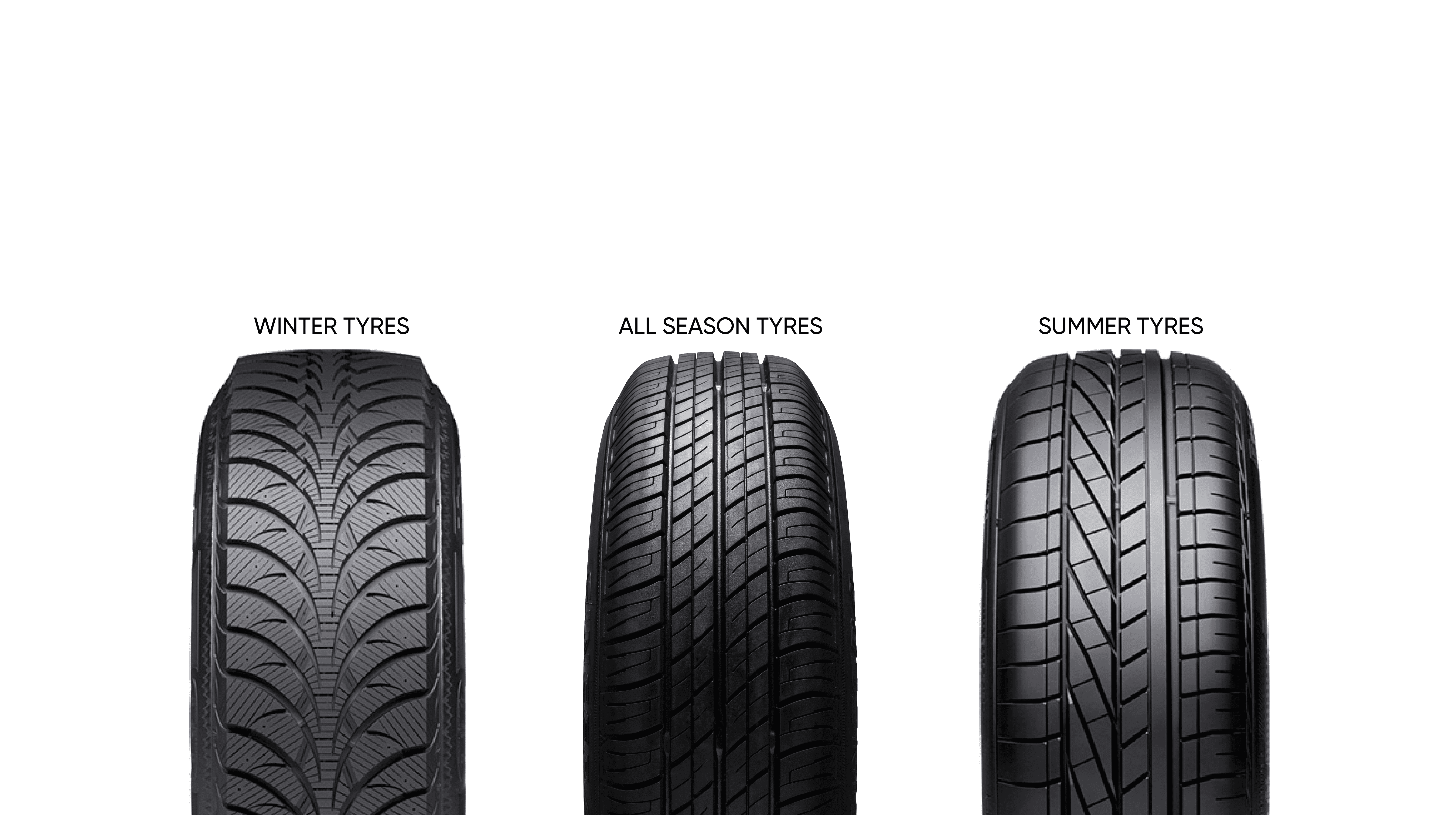how all season tyres-compare to summer and-winter tyres

Tyres play a crucial role in vehicle performance, safety, and fuel efficiency. Choosing the right type of tyre can make a significant difference in how a car handles different road conditions, especially in varying weather. The three main types of tyres available are all-season, summer, and winter tyres, each designed for specific driving conditions.
Many drivers opt for all-season tyres due to their versatility, but how do they compare to summer and winter tyres in terms of performance, durability, and safety? This guide explores the differences between these tyres and helps determine which option is best for your driving needs.
What Are All-Season Tyres?
All-season tyres are designed to perform adequately in a variety of weather conditions, from warm summers to mild winters. They combine features of both summer and winter tyres to offer a balance between grip, durability, and efficiency.
These tyres are built with a moderate tread depth and a rubber compound that remains flexible in a wide range of temperatures. While they provide convenience by eliminating the need for seasonal tyre changes, they do not excel in extreme conditions like heavy snowfall or scorching summer heat.
What Are Summer Tyres?
Summer tyres are optimized for warm and dry conditions, offering superior grip and handling on both dry and wet roads. These tyres are made from a softer rubber compound that enhances traction and braking performance when temperatures are high.
The tread pattern of summer tyres is designed with shallower grooves and fewer sipes, which helps improve contact with the road and increases stability. However, in cold temperatures, the rubber hardens, reducing grip and making them unsuitable for winter driving.
What Are Winter Tyres?
Winter tyres are engineered to handle snow, ice, and cold temperatures. They are made with a softer rubber compound that stays flexible in low temperatures, ensuring better traction and control.
Winter tyres feature deeper treads, more sipes, and specialized tread patterns that help channel slush and grip icy surfaces. They provide superior handling and braking performance in cold conditions but tend to wear out faster and perform poorly in warm weather.
Key Differences Between All-Season, Summer, and Winter Tyres
Tread Design and Pattern
- All-season tyres have a moderate tread depth and balanced tread pattern, making them suitable for various road conditions but not optimized for extreme weather.
- Summer tyres have a shallower tread pattern with larger tread blocks, providing maximum contact with the road for better grip and handling in dry and wet conditions.
- Winter tyres feature deep tread grooves and high-density sipes, improving traction on snow and ice by effectively biting into the surface.
Rubber Compound and Temperature Performance
- All-season tyres are made from a rubber compound that stays flexible across moderate temperature ranges but may lose effectiveness in extreme heat or cold.
- Summer tyres use a softer rubber compound designed to perform well in high temperatures, offering better grip but hardening in cold weather.
- Winter tyres have a unique compound that remains flexible even in sub-zero temperatures, maintaining grip on icy or snowy roads.
Performance on Dry Roads
- All-season tyres perform well on dry roads, but they do not provide the same level of grip and responsiveness as summer tyres.
- Summer tyres offer the best handling, cornering stability, and braking performance in dry conditions.
- Winter tyres are not designed for dry conditions and may feel soft or less stable, wearing out faster when used in warm weather.
Performance on Wet Roads
- All-season tyres provide decent wet traction, but their grip is not as strong as summer tyres in heavy rain or winter tyres on icy roads.
- Summer tyres offer excellent hydroplaning resistance due to their specialized tread design, making them ideal for rainy conditions.
- Winter tyres have deep grooves that effectively disperse water and slush, reducing the risk of skidding on wet and icy roads.
Performance in Snow and Ice
- All-season tyres can handle light snow but struggle in heavy snowfall and icy conditions due to their tread design and rubber stiffness in extreme cold.
- Summer tyres are completely unsuitable for snow and ice, as their rubber hardens and their shallow tread provides almost no grip.
- Winter tyres perform exceptionally well in snow and ice, offering better braking, control, and traction on slippery surfaces.
Durability and Lifespan
- All-season tyres tend to last longer than summer and winter tyres because they are designed for year-round use. However, using them in extreme conditions can shorten their lifespan.
- Summer tyres wear out faster in high temperatures but last longer if used only during warm months.
- Winter tyres wear down quickly on dry or warm roads, making them less durable if used outside of cold months.
Fuel Efficiency
- All-season tyres offer moderate fuel efficiency, but they are not as optimized for low rolling resistance as summer tyres.
- Summer tyres are designed for maximum efficiency in warm weather, helping to reduce rolling resistance and improve fuel economy.
- Winter tyres have higher rolling resistance due to their softer rubber and aggressive tread, which can slightly reduce fuel efficiency.
Pros and Cons of Each Tyre Type
All-Season Tyres
Pros:
- Convenient for drivers who do not want to switch tyres seasonally
- Good performance in a variety of weather conditions
- Long lifespan and moderate fuel efficiency
Cons:
- Not optimized for extreme winter or summer conditions
- Less responsive handling compared to summer tyres
- Limited performance on icy or heavily snow-covered roads
Summer Tyres
Pros:
- Excellent grip and handling on dry and wet roads
- Superior braking performance in warm weather
- More fuel-efficient in high temperatures
Cons:
- Unsafe in cold, snowy, or icy conditions
- Shorter lifespan if used year-round
- More expensive to replace frequently
Winter Tyres
Pros:
- Best traction and braking performance in snow and ice
- Flexible rubber compound for superior grip in freezing temperatures
- Enhanced safety in harsh winter conditions
Cons:
- Poor performance on dry and warm roads
- Higher rolling resistance reduces fuel efficiency
- Requires seasonal changes and additional storage space
Which Tyre Type Should You Choose?
When to Choose All-Season Tyres
- Ideal for moderate climates with mild winters and warm summers
- Suitable for drivers who prefer convenience and long-term durability
- A good option for areas with light snowfall but not extreme winters
When to Choose Summer Tyres
- Best for warm climates where temperatures rarely drop below freezing
- Recommended for drivers who prioritize performance, handling, and fuel efficiency
- Ideal for sports cars or high-performance vehicles
When to Choose Winter Tyres
- Essential for regions with heavy snow, ice, and freezing temperatures
- Best for drivers who frequently commute on snow-covered or slippery roads
- Recommended for maximum safety and control in extreme winter conditions
Final Thoughts
The choice between all-season, summer, and winter tyres depends on climate, driving habits, and performance needs. All-season tyres offer year-round convenience but may not perform well in extreme conditions. Summer tyres provide superior handling and efficiency in warm weather, while winter tyres ensure maximum safety in cold and snowy conditions.
For those living in areas with mild weather, all-season tyres may be the most practical choice. However, if you experience harsh winters or extremely hot summers, switching between seasonal tyres may be the best way to optimize performance and safety.
